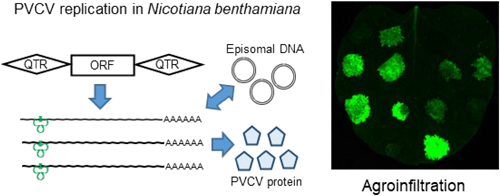- 著者
- Kazunori Kuriyama Midori Tabara Hiromitsu Moriyama Hideki Takahashi Toshiyuki Fukuhara
- 出版者
- Japanese Society for Plant Biotechnology
- 雑誌
- Plant Biotechnology (ISSN:13424580)
- 巻号頁・発行日
- pp.22.1017a, (Released:2022-12-08)
- 参考文献数
- 31
Petunia vein clearing virus (PVCV) is a type member of the genus Petuvirus within the Caulimoviridae family and is defined as one viral unit consisting of a single open reading frame (ORF) encoding a viral polyprotein and one quasi-long terminal repeat (QTR) sequence. Since some full-length PVCV sequences are found in the petunia genome and a vector for horizontal transmission of PVCV has not been identified yet, PVCV is referred to as an endogenous pararetrovirus. Molecular mechanisms of replication, gene expression and horizontal transmission of endogenous pararetroviruses in plants are elusive. In this study, agroinfiltration experiments using various PVCV infectious clones indicated that the replication (episomal DNA synthesis) and gene expression of PVCV were efficient when the QTR sequences are present on both sides of the ORF. Whereas replacement of the QTR with another promoter and/or terminator is possible for gene expression, it is essential for QTR sequences to be on both sides for viral replication. Although horizontal transmission of PVCV by grafting and biolistic inoculation was previously reported, agroinfiltration is a useful and convenient method for studying its replication and gene expression.
- 著者
- Kazunori Kuriyama Midori Tabara Hiromitsu Moriyama Hideki Takahashi Toshiyuki Fukuhara
- 出版者
- Japanese Society for Plant Biotechnology
- 雑誌
- Plant Biotechnology (ISSN:13424580)
- 巻号頁・発行日
- vol.39, no.4, pp.405-414, 2022-12-25 (Released:2022-12-25)
- 参考文献数
- 31
Petunia vein clearing virus (PVCV) is a type member of the genus Petuvirus within the Caulimoviridae family and is defined as one viral unit consisting of a single open reading frame (ORF) encoding a viral polyprotein and one quasi-long terminal repeat (QTR) sequence. Since some full-length PVCV sequences are found in the petunia genome and a vector for horizontal transmission of PVCV has not been identified yet, PVCV is referred to as an endogenous pararetrovirus. Molecular mechanisms of replication, gene expression and horizontal transmission of endogenous pararetroviruses in plants are elusive. In this study, agroinfiltration experiments using various PVCV infectious clones indicated that the replication (episomal DNA synthesis) and gene expression of PVCV were efficient when the QTR sequences are present on both sides of the ORF. Whereas replacement of the QTR with another promoter and/or terminator is possible for gene expression, it is essential for QTR sequences to be on both sides for viral replication. Although horizontal transmission of PVCV by grafting and biolistic inoculation was previously reported, agroinfiltration is a useful and convenient method for studying its replication and gene expression.
- 著者
- Mitsuro Hyakumachi Mitsuyoshi Nishimura Tatsuyuki Arakawa Shinichiro Asano Shigenobu Yoshida Seiya Tsushima Hideki Takahashi
- 出版者
- 日本微生物生態学会 / 日本土壌微生物学会 / Taiwan Society of Microbial Ecology / 植物微生物研究会
- 雑誌
- Microbes and Environments (ISSN:13426311)
- 巻号頁・発行日
- vol.28, no.1, pp.128-134, 2013 (Released:2013-03-12)
- 参考文献数
- 54
- 被引用文献数
- 12 61
Bacillus thuringiensis is a naturally abundant Gram-positive bacterium and a well-known, effective bio-insecticide. Recently, B. thuringiensis has attracted considerable attention as a potential biological control agent for the suppression of plant diseases. In this study, the bacterial wilt disease-suppressing activity of B. thuringiensis was examined in tomato plants. Treatment of tomato roots with B. thuringiensis culture followed by challenge inoculation with Ralstonia solanacearum suppressed the development of wilt symptoms to less than one third of the control. This disease suppression in tomato plants was reproduced by pretreating their roots with a cell-free filtrate (CF) that had been fractionated from B. thuringiensis culture by centrifugation and filtration. In tomato plants challenge-inoculated with R. solanacearum after pretreatment with CF, the growth of R. solanacearum in stem tissues clearly decreased, and expression of defense-related genes such as PR-1, acidic chitinase, and β-1,3-glucanase was induced in stem and leaf tissues. Furthermore, the stem tissues of tomato plants with their roots were pretreated with CF exhibited resistance against direct inoculation with R. solanacearum. Taken together, these results suggest that treatment of tomato roots with the CF of B. thuringiensis systemically suppresses bacterial wilt through systemic activation of the plant defense system.

